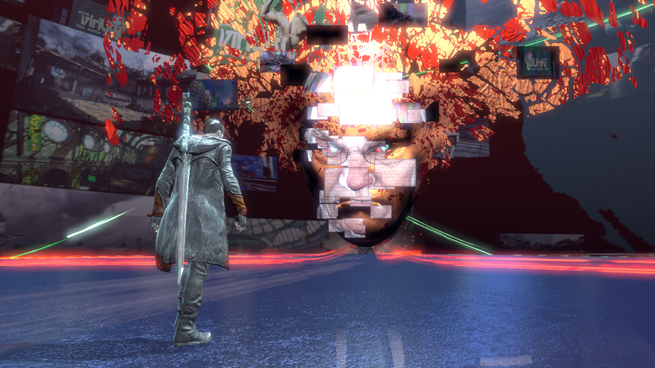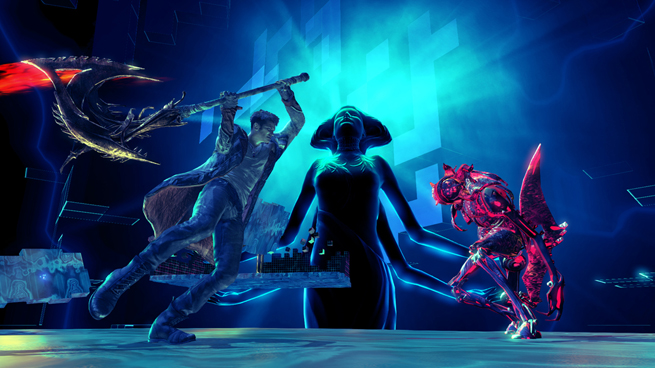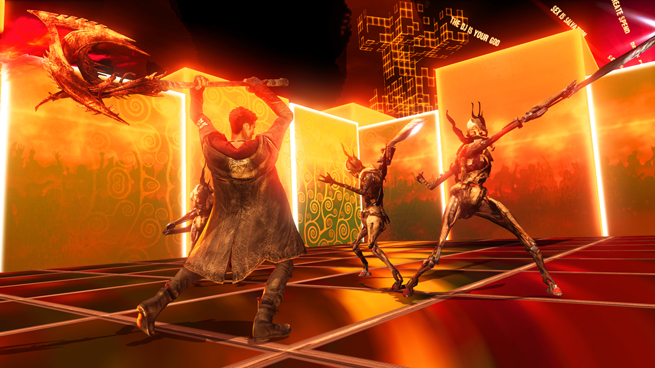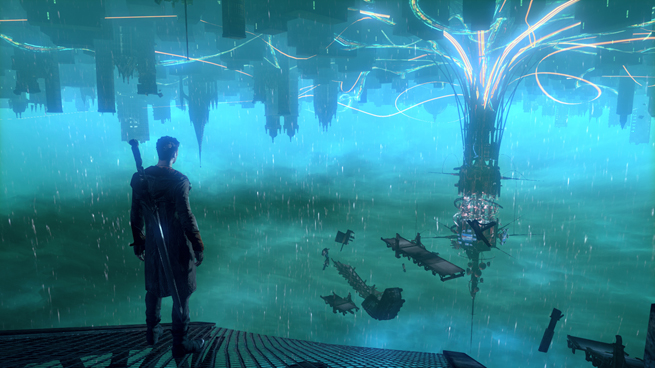What you won’t like
Bad bosses
Out of 20 story missions, you come up against about six bosses, and they’re all lacking — not so much in imagination but in difficulty. Hit the glowy bit. Leap over the attack. Repeat. Done. Yawn.
In fairness, the visuals — often one of DmC’s strong points — still lend some interest. I particularly enjoyed the art direction while taking out Bob “Just doing God’s work!” Barbas, a thinly veiled Bill O’Reilly character who runs Mundus’s media empire. Parts of that fight happen inside his show’s title graphics, with asides shot in grainy black and white from a news helicopter. But Bob himself is a pushover. They all are.
I’ll note one possible exception. Your very last opponent counts as hands down the cheapest final boss in gaming since Street Fighter IV (also from Capcom). Once you see his patterns, it’s fairly easy to crush him even though all the special moves you’ve perfected over the game are largely useless. Then, you knock his life bar down to its final sliver, and he automatically turtles up, becomes completely invulnerable, and sends his shade out to harass you while he regenerates. And this happens every single time. The game gives no indication on how to beat him, so you can easily repeat the process 10 or 15 times without making any headway. The secret lies in using your Demon Trigger powers, but only at a very specific time, which I had to determine through sheer guesswork. That’s just poor design.
Regardless, the regular fights, which routinely throw multiple heavy enemy types at you at once, are tougher and better thought out than any boss in the game. Given the franchise’s past history of murderous big bads, that’s just not right.
A few technical fouls
It’s insane that I’m still suffering with the same bad camera in 2013 that Devil May Cry hit me with over a decade ago, but here we are. Honestly, doesn’t anybody think it’s important to put serious effort into letting me see what’s going on? Because DmC’s camera routinely doesn’t, especially if I’m packed into a small space or close to a wall. A few times, the camera even reoriented itself midjump, so instead of heading for a platform, I dashed out into the abyss. Thanks, stupid camera. You can move it manually, but doing so means taking your thumb away from all the attack buttons. In combat, that’s a fatal move.
For the most part, DmC sports a fun, supersaturated look with some amazing set pieces. A whacked-out neon nightclub and an upside-down corporate headquarters stand out in my mind. But you also get several distracting hiccups, like dynamic shadows that can’t decide whether or not to be dynamic — in cutscenes, no less — and, on my prerelease build, a few major incidents of stuttering and framerate slowdowns.
Scoring high on style and completion during the missions earns you upgrade points for Dante and his arsenal, but this system feels weak. Mainly, you’re unlocking new moves or more powerful versions of old moves, and it does feature a nice try-before-you-buy option where you can practice before you commit. But compared to other recent games — or even Devil May Cry 3’s skill pathways — it seems too grab-bag and unfocused. Midway through, I just started arbitrarily dumping points into whatever I wanted. Something that drove me to a clear play style, like a gun game or aerial-combat specializations, would’ve been much clearer and far more meaningful.
Locked replayability
Here’s one that just plain baffles me. DmC: Devil May Cry doesn’t have any online modes (save for leaderboards), so its longevity largely depends on you replaying the entire campaign on increasingly harder settings. Then it locks those settings. You’re expected to run the full 12-hour campaign twice just to open up intriguing options like “Heaven and Hell” (one-hit kills on everything) and “Hell and Hell” (one-hit kills only on Dante). Really?
Not crazy enough? Well, if you just want to play through a few quick challenge rooms without bothering with the entire campaign, you can always go straight to the secret missions. These hit you with timed exercises — races, killing anything that moves, killing everything with angelic weapons only, etc. Except you must literally unlock them by locating keys hidden in the campaign levels and matching them to also-hidden doors. Really?
Why would anyone think barring the value-add content was a good idea? Because more than anything, it encourages me to walk away after one playthrough, and there’s a name for games like that: rental.
Conclusion
The original Devil May Cry paved new roads in action gaming. As a remake, DmC: Devil May Cry largely repaves the same road, but a gleefully brutal combat system and the patented bad attitude bring the sexy back to mass demon extermination. Even better, the action endures throughout a lengthy campaign with few drops in the tempo — no small feat, that. A strangely onerous approach to replayability, a missed opportunity of an upgrade system, and bosses that come off more as unpaid interns detract from the experience, but overall the team at Ninja Theory did Dante proud. Here’s hoping they get a crack at perfecting the formula in a sequel.
Score: 85/100
DmC: Devil May Cry releases January 15, 2013 for the Xbox 360 and PlayStation 3 and January 25, 2013 for PC. The publisher provided a nonretail Xbox 360 disc of the game for the purpose of this review.
VentureBeat's mission is to be a digital town square for technical decision-makers to gain knowledge about transformative enterprise technology and transact. Learn More




